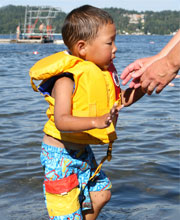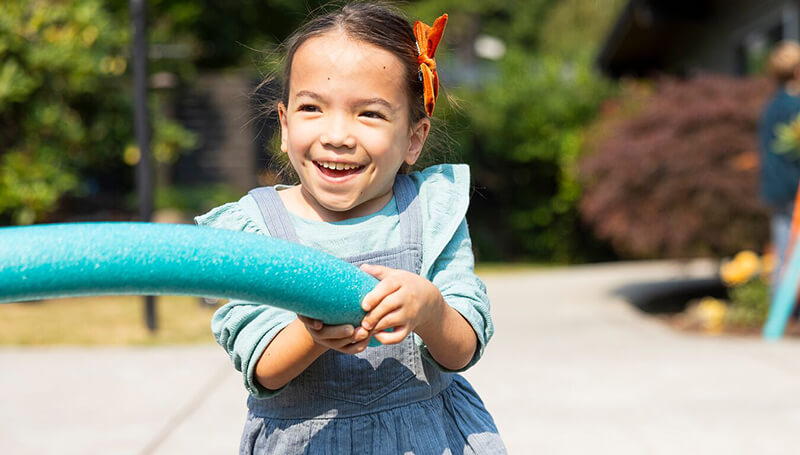Water Safety for Children Birth to 5 Years
 Drowning is the leading cause of unintentional death in children ages 1 to 4. Children under 5 most often drown in swimming pools and bathtubs. Drowning often happens at times when caregivers hadn’t planned for the child to be in the water.
Drowning is the leading cause of unintentional death in children ages 1 to 4. Children under 5 most often drown in swimming pools and bathtubs. Drowning often happens at times when caregivers hadn’t planned for the child to be in the water.
Parents may think that if their child falls in the water they will hear lots of splashing and noise and they will be able to get to their child. In most cases, children slip under quickly and in silence.
Supervision and a life jacket are 2 of the most important things you can provide to protect your child from drowning.
At Home
Babies and young children can drown in as little as 2 inches of water. Hundreds of children have drowned in bathtubs, garden ponds, toilets and 5-gallon buckets.
- Always watch toddlers when in the bathroom.
- Never leave a baby or toddler alone or in the care of another young child while in the bathtub, pool, spa or wading pool.
- Bath seats can tip over and cause a baby to slip out. Only use them with close adult supervision.
- Store buckets empty and out of reach when not in use.
In the yard
- Keep garbage cans covered.
- Store buckets empty and out of reach.
- Avoid having a garden pond. If you do have one, put a fence around it to keep your child away.
- Empty the wading pool when not in use.
In and Near the Water
Start good water safety habits early, while it’s easier.
- Put your child in a life jacket when playing in or near the water, on a dock or in a boat, raft or inner tube.
- In all types of water, stay within touching distance of your child at all times.
- At social events, take turns with other adults being the “water watchers” to watch children in or near the water.
- While watching children near water, adults must keep constant focus on the children and avoid doing things that could distract you such as talking, reading or looking at your phone.
- Buy a life jacket for your child. There may not always be one to rent or borrow. Some swim suits come with built in life jackets. Check the label to make sure it is U.S. Coast Guard approved.
- Talk with your childcare provider to find out if your child will be going on outings near or in the water. Ask about supervision around the water. Provide a life jacket for your child if needed.
- Infant and toddler water classes promote water safety and play, but they do not replace supervision. Most children are ready for swim lessons at about age 4. Some 1- to 4-year-olds are ready to learn to swim. No matter the age, swim lessons do not provide “drown-proofing.”
- Teach your child to wait for your “OK” before getting into the water.
- Choose areas with lifeguards for swimming and playing. Even with a lifeguard, you will need to watch closely.
- Water wings, rafts or plastic rings are not designed to keep swimmers safe. Never use them in place of a life jacket.
If You Have a Pool or Hot Tub
Mishaps can happen just outside your door, so use many layers of safety to protect your child. These include barriers, fencing, alarms, safety covers and rescue gear.
All pools pose a drowning risk. Soft-sided inflatable pools have the same risks as in-ground pools. Young children can get into them with ease and have trouble getting out.
- Enclose pools on all 4 sides with a fence at least 4 feet high and an entrance that has a self-closing, self-latching gate. Make sure the fence is hard to climb to further prevent a child from getting in without help. Get detailed guidelines on fencing from poolsafely.gov.
- Add a power safety cover, alarms on doors leading to the pool and a pool alarm. Safety covers are not a substitute for a fence.
- Learn infant and child CPR.
- Cover hot tubs when not in use.
- Use drain covers, safety vacuum release systems (SVRSs) or filter pumps with multiple drains to prevent children from getting entrapped in drains.
- If your child has long hair, use hair bands to keep hair away from the suction drain covers.
- Keep a phone right by the pool. Add emergency phone numbers to your contacts and post the numbers near the pool as well.
- Keep rescue gear such as a life buoy, life jackets and a reach tool (shepherd’s crook) next to the pool.
- Remove toys from in and around the pool when it is not in use. Toys attract children to the pool.
On Vacation
Vacations often happen in places where children have access to pools, hot tubs and open water.
- Bring your family’s life jackets on vacation.
- The change in routines makes it easy for a child to slip away unnoticed. Keep young children in sight at all times when water is nearby.
- If a child is missing, check the pool first.

